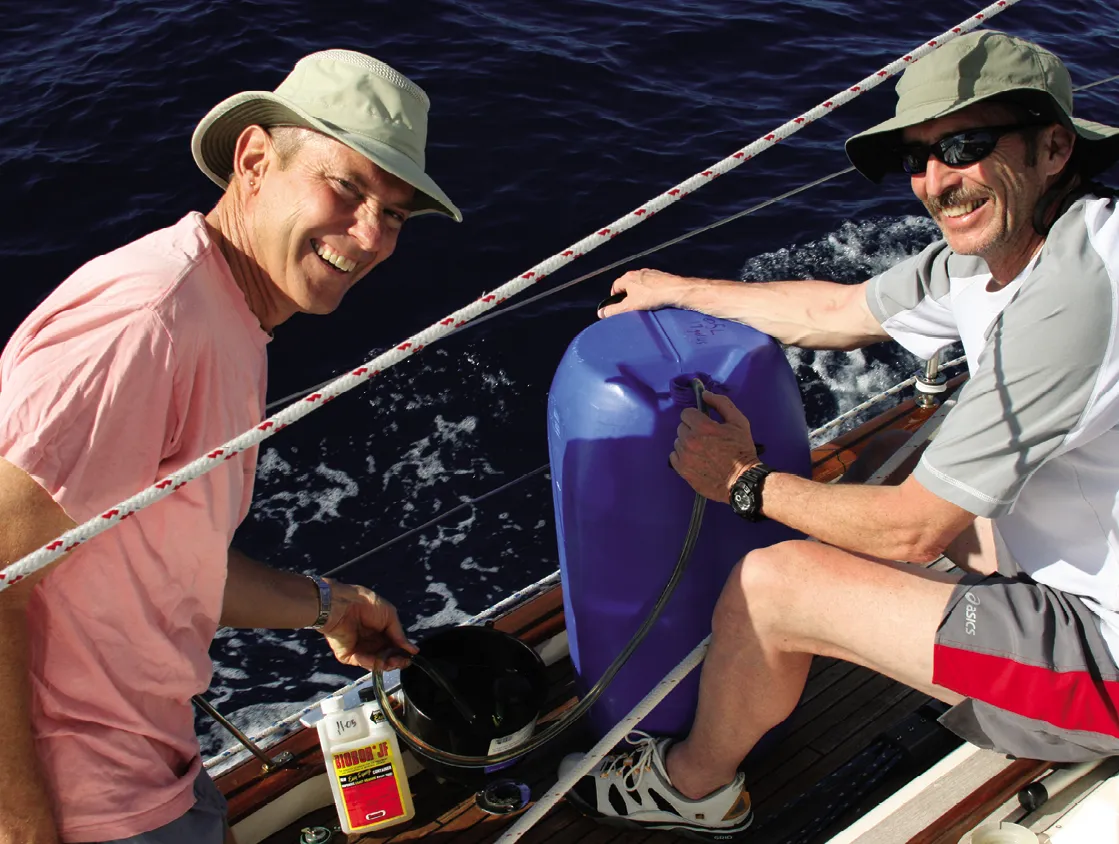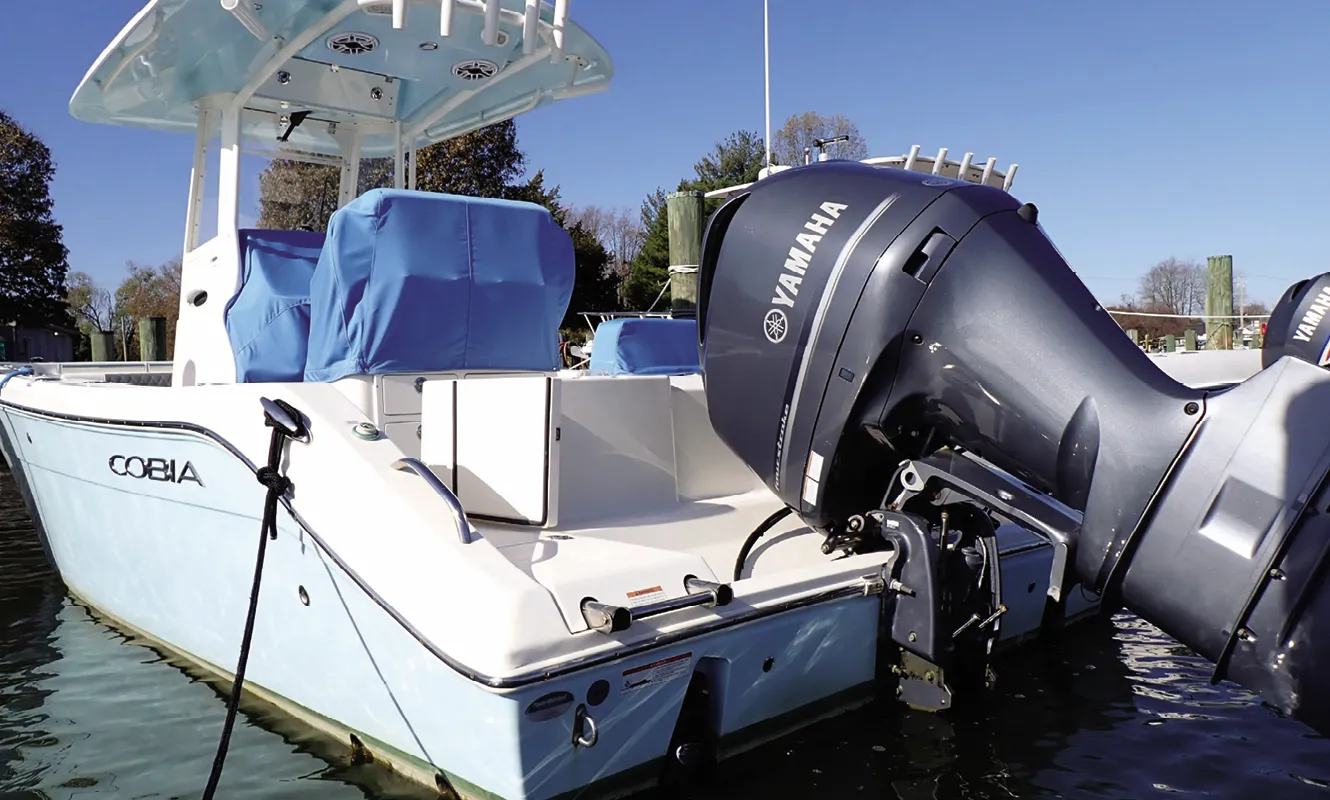Asailing auxiliary engine should never be fully relied upon to bash into a storm; they are not sized for that. In many boats, the prop will cavitate as it moves up and down, and fuel range is limited. This also holds true for outboard powered sailboats, in which the motor should be regarded as a tool for getting in and out of harbors, getting home on windless afternoons, and at most, transiting canals and rivers.
Nevertheless, when weather turns bad, engines can be an important asset, provided yours is ready for the job.
DEEP OIL SUMP
A deep oil sump is vital when motor sailing in strong conditions. Check your engine specs for maximum and intermittent heel angles. Keeping the oil on the full side will help, as will keeping a close eye on the oil pressure and temperature. Do not overfill, and be mindful that on many engines the oil level reads falsely when heeled, either high or low, because the stick is not centered.
KEEP THE FUEL TANK CLEAN
Use an oil change pump (not a drill pump!) to “sump” the fuel tank once a year. If you don’t have easy access to its baffled chambers, you can make a long, stiff wand from a length of copper or aluminum tubing and snake it down to the deepest corner of the tank. Suck out all the water and a little more, until the fuel is clear. Sumping tanks is common practice on aircraft and in refining.
A fuel polishing system, if able to turn the tank over in less than an hour, can also be used for this. However, unless you proactively operate them during boisterous conditions, most low-flow polishing systems will not help remove the sludge and contaminants that get stirred up in a storm.

Always treat with Biobor JF or another biocide to prevent a bug infestation. But most importantly, if the tank is not clean right to the bottom, clean it now; there is no substitute for a shiny tank. Spare filters are important, and the filtration system should be set up in a way that allows you to easily change or switch fuel filters on the fly while the boat is bucking. Is there is a strainer on the pick-up end of the fuel line? Can you pop it out if it gets clogged?
WET EXHAUST LOOPS
You don’t want waves coming in through wet exhaust loops. Boats have sunk at the dock because this loop got submerged. A powerful stern wave can push water into the system.
There should also be a high loop on the fuel tank vent. Getting water in the fuel as a result of a knockdown or even severe heel is all too common.
WATERTIGHT FILLER CAP
Inspect or replace the filler O-ring annually and replace it if it is older than five years. After five years, it has almost certainly been permanently compressed and is not sealing as well as it was when new. Clean the threads and grease both the cap and the threads annually with waterproof grease.
OVERBUILT COOLING SYSTEM
Regularly clean the pipes and heat exchanger (see “Descaling Solutions for Boats, PS August 2017). Install an easy-to-clean strainer above the waterline. If there is an external strainer, clean it every few months, or more frequently if needed.
ENGINE AIR INTAKE
Rags and debris can fly around the engine room in a storm. If the engine lacks a true air filter, there should be at least a screen to prevent debris from getting sucked in. See “In Search of Better Filters,” PS February 2020.
NOTES ON OUTBOARDS
If there is an integral tank on your skiff, can you put a cap or other protection over the vent? If it rains or if there is heavy spray, will it enter the tank?
In following seas or when the boat is bucking heavily, the carburetor can suck in water or the ignition can short if the cowling isn’t snug. Inspect the cowling gasket and replace as needed. There should be no gaps and the latches should feel tight.
Do you have a spare prop and shear pin? A trapline or floating log can shear the pin or strip the prop hub. The tilt lock can also fail, so have some Dyneema cord to lash down the engine.
PHASE SEPARATION
Phase separation of ethanol fuel leads to serious water contamination. Humidity entering through the vent is enough to start the process (See “EPA Mandate Sparks Fuel-vent Filter Test,” PS January 2013). It takes just a few ounces of water through the tank vent or fuel fill pipe to cause the fuel to separate into two layers, the upper containing low-octane gasoline and the lower containing an unusable solution of about 80 percent ethanol and water. The quantity will be too great for a separating filter to deal with.
Separating filters can’t fully remove water from e10 because the ethanol phase is too light, the surface tension is too similar to gasoline, and the water-repellent filter media does not repel the ethanol-rich aqueous phase.
The solution is to use a length of hose to siphon good fuel from the top of the tank into another smaller tank that can be plumbed to the engine.
The EPA memo on gasoline phase separation concisely explains the problem: www.epa.gov/sites/default/files/2015-09/documents/waterphs.pdf. Our special report “Marine Fuel Additives,” anthologizes all previous PS reports on keeping fuel clean (www.practical-sailor.com/product/marine-fuel-additives).


































